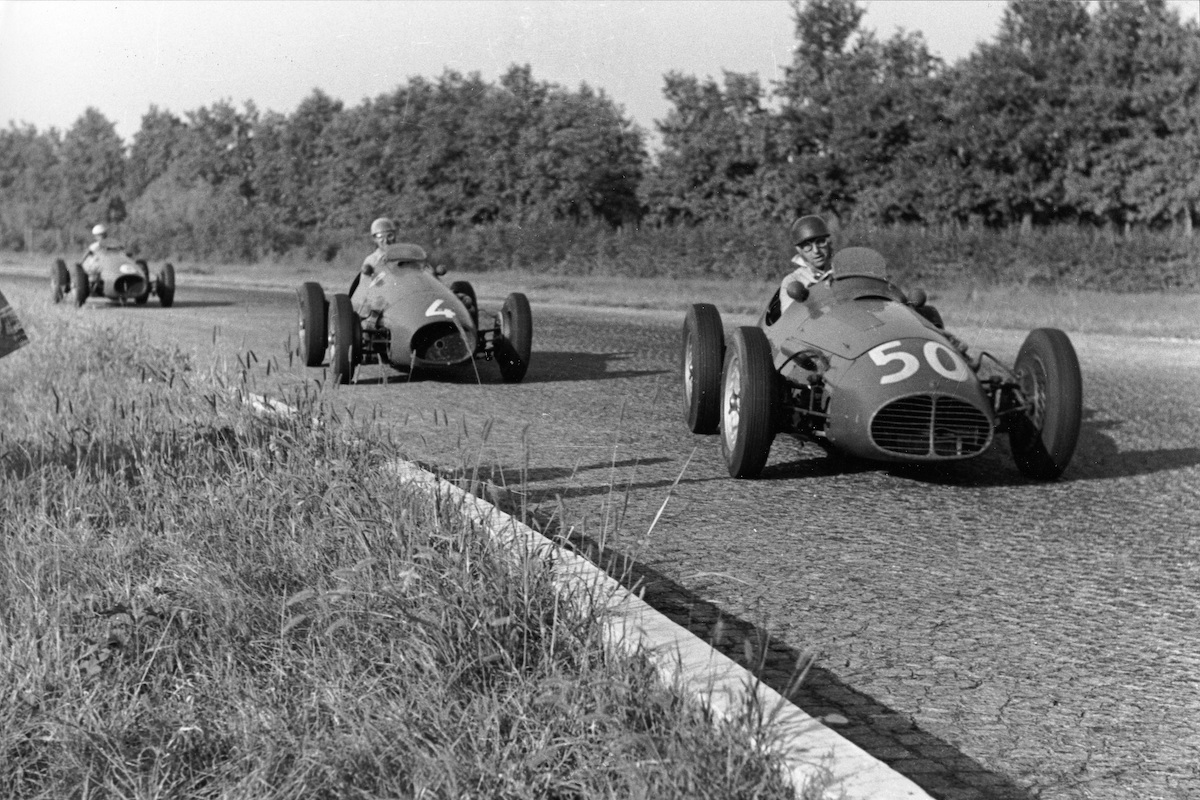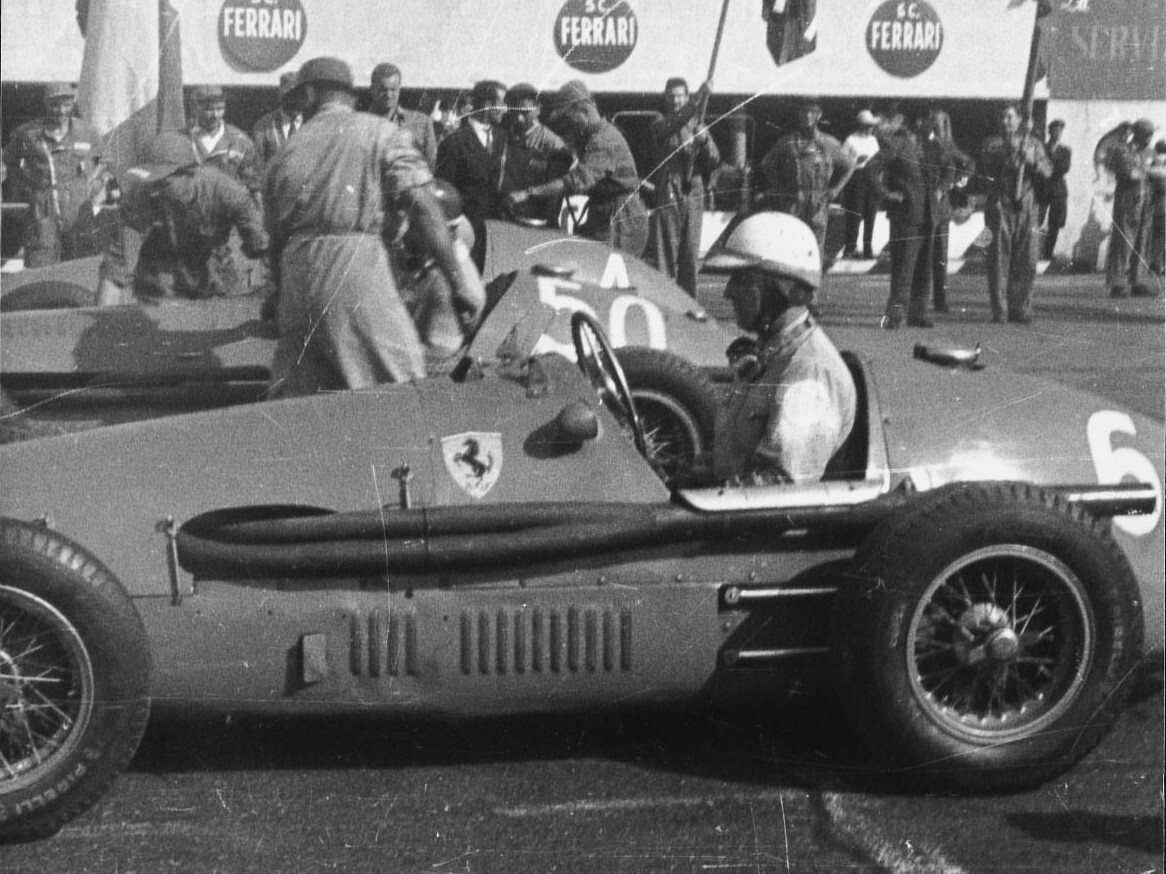
Photo: Maserati
With new teams queuing up to gain entry to Formula 1, it is hard to imagine today that a shortage of available cars could result in the World Championship being run to Formula 2 regulations. But from 1952 to 1953 that is exactly what happened.
In bringing this two-year interlude to an end, the 1953 Italian Grand Prix, held 70 years ago on 13 September, therefore marked the last World Drivers’ Championship victory for an F2 car.
Formula Scout delves deep into the archives to explain what pushed the FIA into this decision and why that race was remarkable for more reasons than one.
Formula 2 (or Formula B as it was initially called) had been created by the forerunner of the FIA in October 1947 with the aim of generating increased interest from the motor industry by offering a technologically simpler and cheaper alternative to Formula 1, which had come into being one year earlier.
The rules specified normally-aspirated engines of up to 2000cc, with an option, largely ignored, for 500cc supercharged engines instead.
The first race for the new formula took place in Perpignan in April 1948, with Maurice Trintignant taking victory in a Gordini-Simca, while Ferrari made its first appearance with a stripped-down sportscar at the Bari Grand Prix in May 1948, with pre-war ace Tazio Nuvolari one of its drivers, four months before the debut of Ferrari’s first F1 car.
The F1 World Championship itself was launched in 1950, with the opening round taking place at Silverstone in May.
Having dominated the first two seasons, Alfa Romeo shocked the sport by deciding to withdraw from Grand Prix racing at the end of 1951, throwing the future of the fledgling championship into jeopardy.
The only possible rivals to Ferrari were the British Racing Motors (BRM) factory who had designed an impressive sounding but hugely complex and ultimately rather disappointing V16-engined monster. The future of F1 hinged on the competitiveness of the BRM.

Alberto Ascari (Photo: Ferrari)
However, when the British team failed to appear for the non-championship Valentino GP in Turin, it was the race organisers rather than the FIA that took the initiative. One after the other, they gave up on F1 and announced that they would run their races for F2 cars only, with the continued exception of the even more anomalous inclusion in the calendar of the Indianapolis 500.
Faced with a fait accompli, the governing body had no alternative but to declare the World Championship for F2 cars, in the hope that other manufacturers would provide some competition to a strong Ferrari team, led by the fast Alberto Ascari, whose father Antonio had won the Italian GP in 1924.
The move did attract interest from a variety of manufacturers, including Gordini, HWM, Cooper and, most significantly, Maserati, but none was a match for the dominant 4-cylinder Tipo 500 Ferrari, one of motor-racing’s all-time classic designs, which had first appeared in 1951.
Not for the first time and certainly not for the last, regulation changes intended to close up the field actually had the opposite effect, leading to one of the most dominant driver/team combinations in the history of the sport.
Having missed the opening round in Switzerland in order to take on the Indianapolis 500, Ascari won all six remaining rounds in 1952 to comfortably win the title.
Maserati, expected to be the main challengers to their Italian rivals, were also absent in Bern but soon suffered an even bigger blow.
The 1951 World Champion, Juan Manuel Fangio, had joined the team after Alfa Romeo’s withdrawal and made his debut three weeks later in the non-championship Monza GP driving the new Maserati A6GCM.
Fangio had been racing one of the fearsome V16 BRMs in the Ulster Trophy, a non-championship F1 race at Dundrod in Northern Ireland, the day before and after flying to Paris, had driven through the night to get to the circuit for the race.

Fangio at Reims (Photo: Maserati)
After missing qualifying, he started from the back of the grid. Exhausted, he made a mistake in the race, spun wide at Lesmo, hit a straw bale (no Tecpro barriers in those days) and rolled the car.
Fangio was flung out of the car (no seatbelts either), lying unconscious and gravely injured by the side of the track as the race continued without him. With broken vertebrae in his neck, he would take no further part in the 1952 season.
For 1953, Ascari continued where he had left off with another three wins – thereby setting a record of nine consecutive World Championship Grand Prix wins only surpassed by Max Verstappen earlier this month.
His run was broken not by a rival from another team but by his Ferrari team-mate, dashing up-and-coming British driver, Mike Hawthorn, at the French GP.
Ascari won twice more through the summer, with 1950 World Champion Giuseppe Farina maintaining Ferrari’s 100% record with victory at the Nurburgring when an errant front wheel cost Ascari another certain win.
Fangio had returned to the cockpit at the opening round, appropriately in Argentina, and the Maserati package began to look increasingly competitive in the hands of Fangio and compatriot, Jose Froilan Gonzalez.
Through the summer, Fangio had run the Ferraris close, finishing second in the French, British and German GPs, and taking pole in Belgium and in Switzerland.
Coming to Monza for the final World Championship GP of the year, Ascari had already wrapped up his second title. For Fangio, it was his first return to the scene of his 1952 crash.
Though Ascari again started from pole, he was unable to pull away from a four-car pack with Farina, Fangio and the Maserati driven by Fangio’s protege, Onofre Marimon. The lead changed hands frequently, often multiple times per lap, as the quartet slipstreamed each other down Monza’s long straights (no DRS and no chicanes), diving through traffic (without the aid of blue flags to clear an unobstructed path).

Photo: Maserati
Marimon dropped out of the battle after a stone pierced his oil radiator, rejoining three laps down but right in the middle of the leading group.
Rounding what is now the Parabolica on the last lap, Ascari appeared to run wide on some oil, spun and was rammed by Marimon, with Farina taking to the grass in trying to avoid his team-mate.
Somehow Fangio threaded his way through the chaos to take the flag, recording the first ever World Championship victory for Maserati, and bringing to a close this odd chapter in the sport’s history.
While chaos in a race at Monza for F2 cars is far from unusual, it is maybe surprising for modern readers that a race could run for almost three hours without a single safety car or red flag.
In addition to being the last World Championship event before the introduction of new Formula 1 regulations for 1954, the 1953 Italian GP at Monza was noteworthy for two other reasons.
After complete domination by Ferrari, winning all 14 World Championship Grands Prix held over two seasons, Maserati had finally broken Maranello’s stranglehold with victory, the first ever for the Modena factory.
This record of continuous World Championship Grand Prix victories by a single manufacturer remained unbeaten until Verstappen scored Red Bull’s 15th win in a row almost exactly seven decades later at the 2023 Italian GP.
Maserati would take a further eight wins in the rest of the decade, earning Fangio the 1957 World Championship, before withdrawing as a works team the following year. Maserati remained absent from single-seater racing for over 60 years before returning to competition in Formula E in 2022.
Following Monza, Enzo Ferrari announced that he was pulling out of motor racing, although fortunately this has been a common occurrence in the team’s history and the decision was soon reversed. There are still plenty of pages to be written in Ferrari’s World Championship history.

Farina, Fangio and Ascari on the front row at Monza (Photo: Ferrari)
Ferrari made a brief return to F2 in the 1960s, with Tino Brambilla winning twice in 1968 in European F2, before withdrawing finally in 1969 to concentrate its efforts on F1. However, in 1977 a Ferrari-powered privately-entered Chevron did take Ferrari’s final win in the category in the hands of Lamberto Leoni.
Thoroughbred F1 cars returned, as planned, for 1954, with a new 2.5-litre formula which would last until 1961. The F2 category limped on although virtually no races were staged until a new 1.5-litre formula was introduced in 1957, which itself mutated back into the 1961 F1 regulations.
While Fangio would go on to win the next four World Championships for Mercedes, Ferrari and Maserati before retiring in 1958, Ascari never again had the machinery to take the fight to his great rival. In 1955, he took part in an unplanned test at Monza, crashing fatally at the Curva del Vialone, since renamed in his honour as the Variante Ascari.
Formula 2 cars did continue to compete against their F1 siblings on occasion through the 1950s and 1960s, whenever the field needed some extra entries or the circuit length permitted a larger grid. Jacky Ickx famously qualified an F2 car third for the 1967 German GP at the Nurburgring.
Of course, it couldn’t happen today. F1 being left with just Ferrari and a couple of backmarkers? Of course, that did actually happen at Indianapolis in 2005, although that was a one-off race not a whole championship. And nobody thought to invite F2 to take over the remaining races.
But yet….
Ironically, we may witness the driver of an F2 car taking victory in a World Championship Grand Prix again in 2024.
Not at the circuit but in the cinema.
The fictional APXGP team, seen filming at Silverstone and Monza this summer, has been using modified Dallara F2 cars for drivers Sonny Hayes and Joshua Pierce, played by Brad Pitt and Damson Idris, for the forthcoming Lewis Hamilton-backed racing movie. An F2 champion, Luciano Bacheta (from the MotorSport Vision-run series of 2012), has been driving the cars along with Superleague Formula star, Craig Dolby.
The plot is naturally a closely-guarded secret but it is hard to imagine that the stars of Hollywood won’t win at least one race.